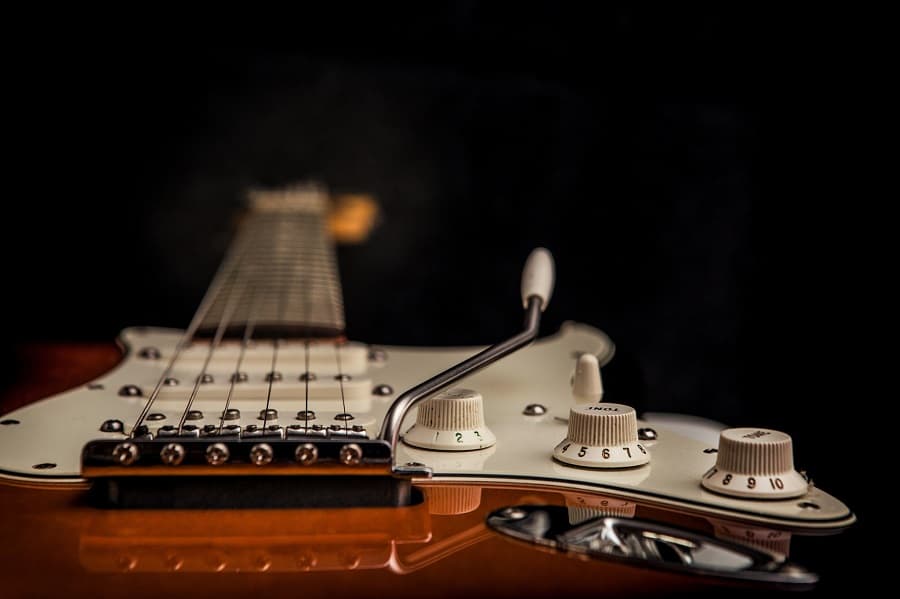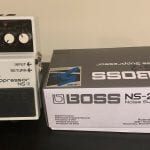It’s tough to enjoy all types of guitar music without the thrill of the whammy bar.
Some understandably despise the whammy, while others only jam with one.
Either way, you should acquaint yourself with the knowledge of what makes these guitar additions so unique.
Not every guitar has one of these magical little apparatuses but, among those that do there is a wide variety and diverse setups that each require a different format.
You can utilize a whammy bar for a vast variety of playing styles and types of music from the subtle cat purr to heavy metal dive bombs and the awesome textural variety of bands.
A large portion of playing guitar is sense of feel and it’s amazing what this little lever can do to enhance that sense.
The reality is, many guitarists don’t appreciate what makes one whammy bar different from the next.
Fortunately, we’ve created this article to enlighten you with all the whammy bar information you’ll ever need.
Contents
What do whammy bars do?
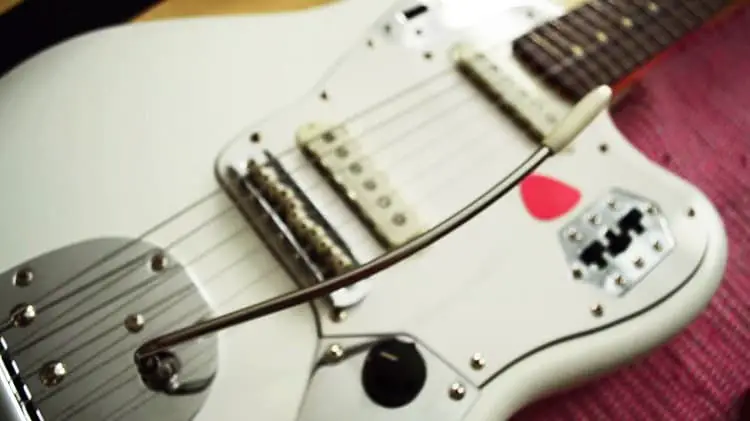
A Whammy bar, or as it sometimes known, a tremolo bar simply alters the tension on the strings all at once.
Some guitars with whammy bars have what is called a floating tremolo, which means the strings can be loosened, lowering the pitch, by pushing the bar towards the guitar body, or the strings can be tightened, therefore raising the pitch by pulling the bar away from the body of the guitar.
Because the tension of each string is different, and the effect of the changing tension differs, depending on the frequency of the note, the variation in the pitches of each string is dramatically different, so the guitar does not stay in tune as the bar is moved.
The drawback of a whammy bar installed on your guitar is that when you break a string, the entire guitar goes out of tune because the tuning is a balance between the string tension and the whammy bar springs on the underside of the guitar.
When one string breaks, the spring tension pulls harder on the remaining strings sending them out of tune as well.
What’s the difference between a whammy bar and a tremolo bar?
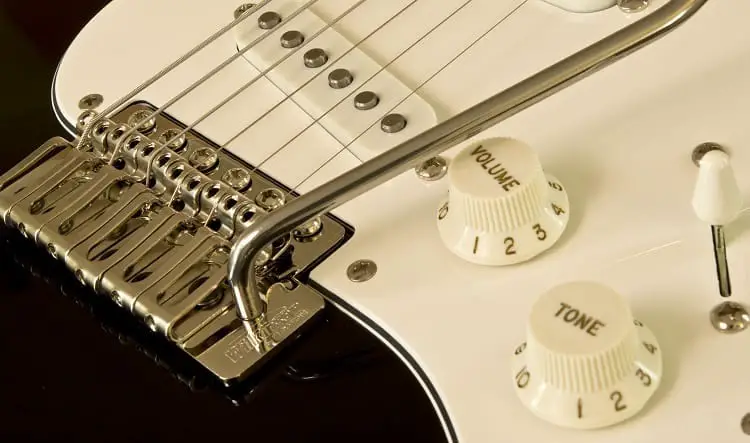
Let’s start by getting the terminology straight: tremolo/vibrato/whammy bar/arm, and tremolo/vibrato system/tremolo bridge all refer to pretty much the same things.
Technically, the effect is a change in vibrato, because manipulating the bar changes pitch. Tremolo, on the other hand, refers to a change in volume.
But the two terms have come to be used almost interchangeably. Whammy is just the nickname for the locked tremolos.
Usually people use the term Whammy when it’s a “tremolo” that can be dive-bombed, abused, frilled, etc.
The proper term for the “whammy bar” is “vibrato arm“. A “tremolo system” refers to all components of the tremolo unit, which can include the tailpiece, the bridge, the nut and the tremolo bar.
And it helps to know that the terms “tremolo bar”, “vibrato bar” and “whammy bar” are all used interchangeably—as are the terms “bar” and “arm”.
Why is it called a whammy bar?
The term “whammy” is an onomatopoeic slang term that has come into use since the 1950s. It is most often associated with bridges that can perform extreme pitch bends.
The first whammy bar came from the Fender Stratocaster design, and were followed later by the Floyd Rose and Kahler designs.
There are two main types of whammy bars, the detachable ones (Floyd Rose and Fender style) and whammy bars that require a tailpiece (Bigsby).
A Whammy bar is a lever attached to the bridge or tailpiece of an electric guitar that can be depressed to increase the tension of the strings and produce such effects as vibrato, portamento, and dive bomb.
Who invented the whammy bar?
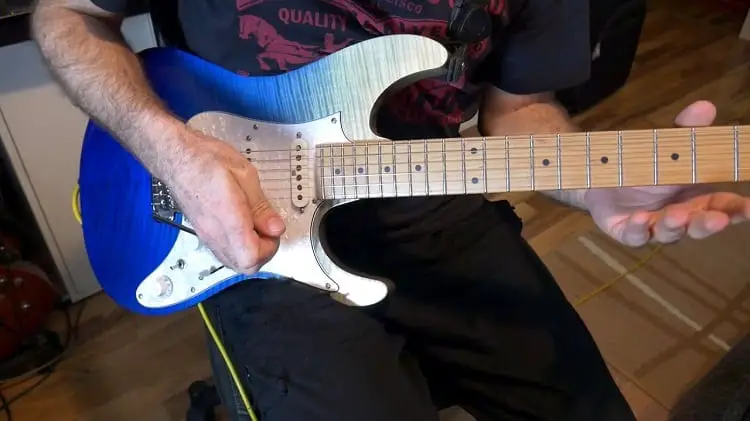
Whammy bars, are often referred to as tremolo or vibrato bridges.
If we’re getting down to details, are pretty commonly found on popular electric guitars throughout the world.
They go back to the 1930s when Doc Kauffman created and patented the very first mechanical vibrato unit.
After building this device, originally known as the “Vibrola,” on a few Epiphone Archtop guitars during the late ‘30s, the design took off. Every guitar company wanted in on the action.
Merle Travis, a favorite country guitarist of the time, was sick of his guitar going out of tune thanks to his unreliable, spring-loaded Vibrola.
He commissioned his friend, Paul Bigsby, to fix it. Paul ended up going overboard with his “fix” and ended up creating the first true vibrato system, the Bigsby.
The Bigsby Vibrato has a rocker bridge as the main component. Instead of the strings going through holes, they wrap around a metal bar that is attached to the tremolo arm.
A guitarist can push the arm down and loosen the strings to get the drop in pitch.
Before the Bigsby vibrato/tremolo bridge came out, the idea of the whammy bar hadn’t quite reached the general public.
Today, the Bigsby is probably one of the most unique whammy bars around. It has a smooth, easy-to-use feel, and is often seen on vintage, archtop guitars.
In terms of staying in tune, it’s not the best, and its pitch bend is not as dramatic as others. Basically, if you’re looking for a smoother, more subtle whammy bar, the Bigsby is one of the best.
The next advancement in the world of tremolos came from Leo Fender, the head designer, and inventor of Fender guitars. The Fender synch tremolo first appeared on the Fender Stratocaster, released in 1954.
The idea was to create a tremolo with a greater pitch range, as well as a tremolo that was capable of bending up.
When Leo Fender came up with his tremolo design, he decided to make the first ones with floating bridges before sticking with the more stable synchronized tremolo.
The reason it was named the synch or “synchronized” tremolo was because the saddle and strings were meant to move in unison like one significant movement.
This helped to eliminate string friction with the saddle, and in turn, helped the strings to move back to their original tuning and tension when the bar was laid to rest.
In terms of design, the tailpiece is made out of a singular piece of metal that sits flush in the body of the guitar, with holes in the top to allow the strings to go through.
The actual arm moves through the bridge and into the tailpiece, making it far more stable than the Bigsby.
Most modern tremolos used this design as inspiration to innovate with. It is easily one of the most influential whammy bars in history.
In 1979, Floyd D. Rose developed the very first locking tremolo, known today as the Floyd Rose Tremolo.
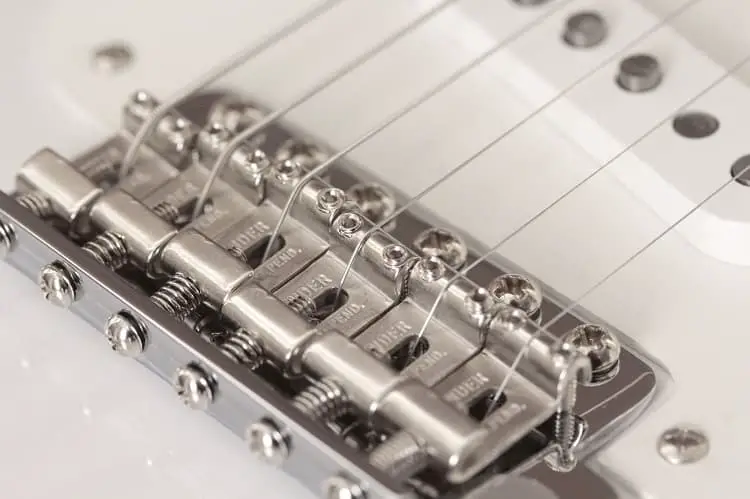
Many people believe that Eddie Van Halen was the man who pushed the Floyd Rose Tremolo to stardom, as he was one of the most prominent Shredder-style guitarists of the time.
Still to this day, if you are a rock or metal guitarists, a locking tremolo is a must.
The actual design of the locking tremolo shows a ton of influence from the Fender Synch tremolo, though the big difference is that the strings are locked in place for stability in tuning and intonation.
The way it works is you tune your guitar as desired, and then lock the nut and bridge with the included Allen key.
This meant that you could tune down to a drop D or C and still remain in tune while dive-bombing those low notes.
Because the Floyd Rose locking tremolo is a floating system, the pitch can be raised or lowered without much work.
This is because there is an open space behind the tremolo where the springs “float” between the tremolo and body.
If you’re looking to get those Eddie Halen-style dives and bends, look no further than a locking tremolo.
You’ve most likely seen these types of bridges before, as they raise up off the body of the guitar.
The reason so many people love this style of bridge/whammy bar is that you can manipulate the pitch up or down much easier.
The action sits much lower as well, meaning you can use it to give life to those long chord strums.
The main issue with floating bridges is that they go out of tune very easily if one string bends or breaks. This is because the strings on a floating bridge are balanced together.
However, if you’re looking for something that is a bit more natural sounding to help sweeten up your playing a bit like Stevie Ray Vaughan, a Fender Floating Bridge is your best bet.
These types of tremolos were found mostly on old Jazzmasters, as well as Jaguars, Mustangs, and a few vintage Fender Bass VI guitars as well.
Can any guitar have a whammy bar?
Technically, yes.
However, depending on what type of guitar you have, your tuning will be affected by heavy use of the whammy bar.
Cheaper guitars will go out of tune much faster than higher quality guitars.
The other downside of adding a whammy bar is the added abuse or tension on your strings will still cause them to stretch and weaken faster than a fixed bridge.
Additionally, the spring in the tremolo will become progressively weaker over time.
A good tremolo is designed to reduce this effect as much as possible, but it’s still a tradeoff to consider.
Fitting a new bar on the guitar can be a little tricky and we highly recommend you seek out and have this kind of work done by a professional.
I say this because you may need to cut a new hole, with some precision in your guitar, in order to make room for the mechanism.
How do you keep a whammy bar in place?
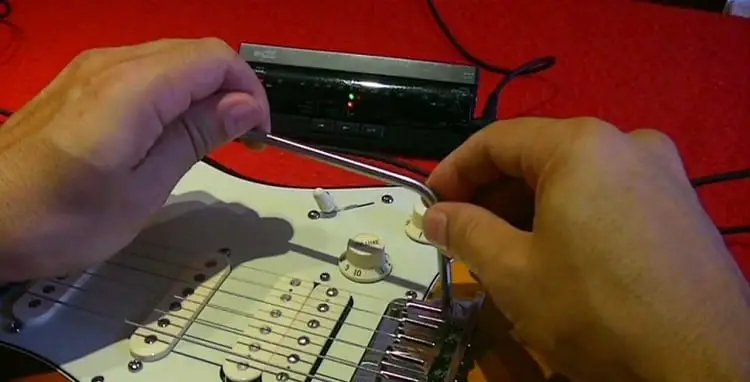
Bar falling into the body?
First of all, it’s worth noting that different models will have different springs, and some are stronger than others.
If this keeps happening to you and you’re using heavy strings, try using lighter strings.
A key issue in using the whammy bar occurs when strings become slack and therefore change position in the nut.
When the whammy bar is returned to neutral, friction at the nut can prevent the strings from returning to their original, natural state, and this can be a large cause of tuning issues.
Start by replacing the nut, or if that is not an option, attach a rubber band from the whammy bar to the bottom strap button. For a more permanent option, superglue is always a choice.
Conclusion
If you really want to learn how to use a whammy bar you should really just spend some time experimenting around with it first.
Try playing a variety of different chords and dropping the arm down to see how the sound reacts.
Dropping the bar at different rates will give you altered sounds so you will have to practice and get a good feel for what sound you are looking for.
Alternatively, you can also do the opposite and start with the bar dropped and raise it.
If you move the bar gently while you’re playing you can get the softer noises as well. It’s really all about having fun with manipulating sounds for a unique style.
Whammy bars are the highpoint of pitch-related effects in the realm of guitars.
Love them or hate them, there’s just nothing quite like using this handy tool to sweeten up your sound and add life to your guitar’s tone.
Understanding the different varieties of whammy bars can help you to know how to make your guitar function in your own way.
We hope that this article helped give you all the insight you’ll ever need on these fantastic devices.
As always, please feel free to let us know if you have questions or share your thoughts of how you use a whammy bar.
Keep rocking and jamming and whammy on!


